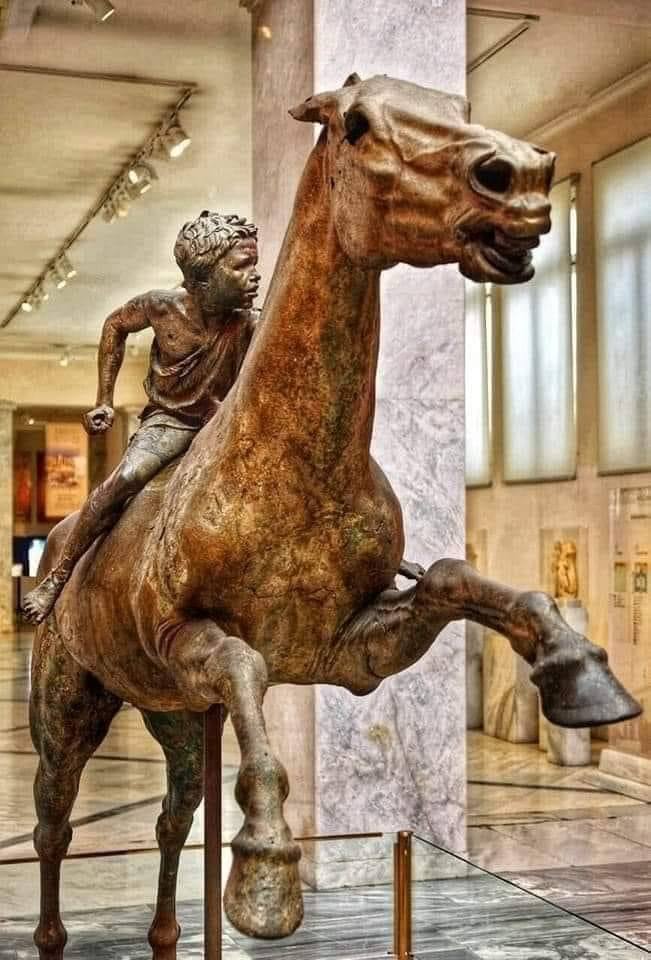Among the vast treasures of ancient Greek art, few masterpieces command as much intrigue and admiration as the Jockey of Artemision. This extraordinary bronze sculpture, dating back to 150-140 BC, stands as an enduring testament to the artistic and technical brilliance of the Hellenistic period. Depicting a young boy mounted on a racing horse, the statue captures a moment of intense competition and vitality, frozen in time.
A Rare Survival Against All Odds
The survival of the Jockey of Artemision is as compelling as the work itself. Over the centuries, countless ancient bronzes met a tragic fate, melted down and repurposed as societies evolved and resources became scarce. However, this exceptional piece escaped such a destiny, finding refuge in the depths of the Mediterranean Sea. Discovered in 1926 near Cape Artemision, the statue’s underwater sanctuary preserved it from the ravages of time and human interference. This miraculous find provides us with one of the few remaining glimpses into the peak of Hellenistic bronze craftsmanship, offering a tangible connection to a civilization renowned for its cultural achievements.

Artistic Mastery in Bronze
The artistic excellence of the Jockey of Artemision is evident in its every detail. The sculptor’s skill is showcased through an unparalleled ability to bring motion and emotion to life in a medium as unforgiving as bronze. The young jockey’s expression reflects intense concentration and determination, while the horse’s muscular form exudes raw power and speed. The composition is so dynamic that it appears almost to defy the immobile nature of its medium, pulsating with an energy that transcends the centuries. This artistic feat is not merely a representation of a boy and his horse but an evocative portrayal of competition, movement, and emotion, encapsulating the human and animal connection in a moment of shared purpose.
The Cultural Significance of the Jockey
Beyond its artistic brilliance, the Jockey of Artemision offers profound insights into ancient Greek culture. Experts believe the statue was commissioned by a wealthy patron to commemorate victories in the prestigious kēles (κέλης), or single-horse races, which were a significant part of Greek athletic competitions. These races held immense social and religious importance, symbolizing not just athletic prowess but also the favor of the gods and the wealth of those who sponsored such events. The statue’s dedication would have served both as a celebration of triumph and as a statement of the patron’s status and devotion to the divine.
A Glimpse Into Hellenistic Society
The statue provides an invaluable window into the values and aspirations of Hellenistic society. Horse racing in ancient Greece was more than a sport; it was a social institution that intertwined athleticism, wealth, and spirituality. The Jockey of Artemision embodies these ideals, reflecting a culture that revered physical excellence, competitive spirit, and divine favor. It also highlights the artistry and technical innovation of the period, as bronze sculptures of this caliber required advanced techniques and significant resources, further underscoring the societal emphasis on monumental achievements.
The Legacy of the Jockey Today
In the modern era, the Jockey of Artemision continues to inspire admiration from both the public and scholars. As one of the few surviving large-scale bronze statues from ancient Greece, it serves as a critical link to the artistic and cultural legacy of the Hellenistic world. The statue’s remarkable preservation allows contemporary audiences to study firsthand the techniques and materials used by ancient artisans, shedding light on the ingenuity and ambition of their craft.
More than just an artifact, the Jockey of Artemision speaks to universal themes that resonate across millennia. Its depiction of intense competition, the pursuit of excellence, and the bond between human and animal touches on experiences that remain relatable in today’s world. By preserving such works, we maintain a connection to our shared human heritage, gaining not only historical knowledge but also a deeper understanding of the values and emotions that transcend time.
Bridging the Ancient and Modern Worlds
The Jockey of Artemision stands as more than an example of Hellenistic art; it acts as a bridge between ancient and modern worlds. Its intricate details and emotive power remind us of the artistic heights achieved by a civilization that thrived over two millennia ago. The statue’s discovery and preservation have made it possible for people today to appreciate the creativity, skill, and cultural significance of a bygone era.
In today’s context, the statue symbolizes the timeless nature of art and its ability to convey the universal human spirit. Its display in museums and academic discussions underscores the importance of preserving cultural artifacts, not only for their historical value but for their ability to inspire future generations. The Jockey of Artemision exemplifies how art can serve as a testament to the enduring qualities of competition, achievement, and the human drive for greatness.
Conclusion
As we reflect on the Jockey of Artemision, it becomes clear that its significance extends far beyond its physical form. It embodies the artistic and cultural achievements of ancient Greece while offering modern audiences a profound connection to the past. This masterpiece transcends its time, reminding us of the shared experiences and aspirations that unite humanity across centuries.
The Jockey’s journey from the depths of the Mediterranean to its current place in the annals of art history is a story of resilience and discovery. It invites us to explore not only the artistry of the Hellenistic period but also the societal values and traditions that produced such remarkable works. In its motionless yet dynamic form, the statue continues to speak to us, a silent yet eloquent messenger from a world long past, urging us to preserve and honor the legacy of those who came before us.





